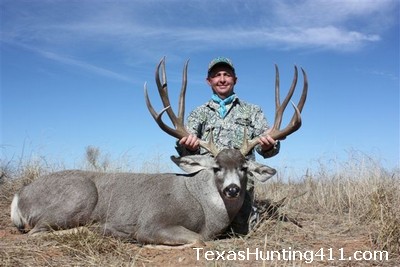The mule deer hunting found across West Texas is pretty darn good, but it’s not by accident. Mule deer are an important resource because the demand for hunting is high and the income generated from hunting packages and leases has been an important component income for most landowners over the mule deer’s range. Their economic value has prompted many ranchers to become more aware of the management needs for mule deer. Indeed, many land use decisions (for example, livestock stocking rate, water developments, brush control) can have a major impact on mule deer. The extent of the impact, and whether it is positive or negative, depend primarily on the degree to which wildlife requirements were considered.
Deer management, like livestock management, varies from one ranch to another depending upon land characteristics and the rancher’s objectives. Just as some areas have a higher grazing capacity for cattle, some areas have a higher carrying capacity for mule deer. Simply stated, deer management involves three principles habitat management, population management and people management. Obviously, each of these will affect the others so it takes the right mix of this inputs to achieve the proper results.

The presence of suitable habitat determines where and in what abundance mule deer will be found. Generally, habitat management involves plant management, the two key points being knowing what plants are important for mule deer food and cover as well as knowing how to manipulate them. For rangeland habitats in West Texas, management tools may include grazing practices, brush management, supplemental water development, prescribed burning and receding operations as helpful wildlife management practices.
The next important factor for producing and maintaining mule deer is population or her management. This means property owners keep the deer population in balance with the habitat’s carrying capacity. It also involves manipulating the age and sex ratios, herd density and other factors affecting population growth (predation, migration, competition with white-tailed deer and exotics). Generally, population management centers around regulating deer harvest levels.
It’s important to note that mule deer and white-tailed deer management are not the same. There is a lack of definitive deer movement patterns and other population-related phenomena, such as natural mortality and competition with livestock which continues to hamper mule deer management in West Texas. Researchers within the state of Texas are conducting ongoing studies to get more information.
Lastly, hunter management is important because it is the means for managing mule deer population. This means landowners, maybe with help from wildlife biologists, must make harvest the proper number of deer annually, and the right deer on top of that. The age structure of the herd is important, especially as it relates to quality and buck harvest. Mule deer management in West Texas is looking good, spurred on by those interested in hunting, but there are still some unknowns that may help in future years. There is no denying that mule deer are interesting animals, and hunting them is a totally different ball game.